Recently I fulfilled a long-standing ambition: I read aloud Thom Gunn’s ‘In Santa Maria del Popolo’ in the Piazza del Popolo, and then visited the church which houses the Caravaggio painting that is the poem’s subject. After the reading – but before the visit – I discussed the poem with the friends I had come to Rome with.
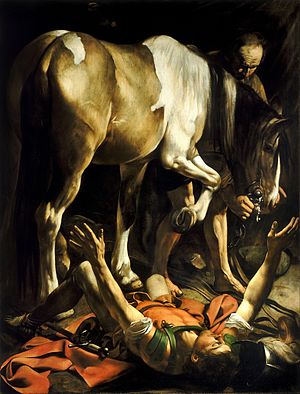
Caravaggio: Conversione di San Paulo (The Conversion on the Road to Damascus, 1601 – Wikipedia)
I had planned to visit the church before the reading and discussion, but like much else on this day – a tour under the rubric ‘From Seneca to Sartre’ – things didn’t go according to plan.
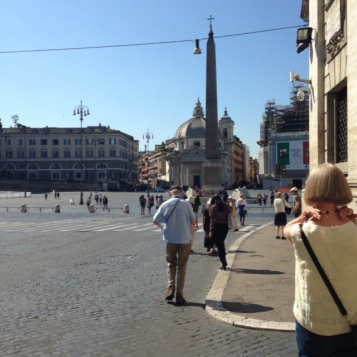
Questers in the Piazza del Popolo: Photo – Sue
We opened the church door a couple of minutes after 10 a.m., found a mass had just begun, and a request not to visit during services prominently displayed. We swapped round the order of events and found a suitable place in the square for a reading and discussion.

Piazza del Popolo By WolfgangM – Flickr.comOriginal photo [1], CC BY 2.0, https://commons.wikimedia.org/w/index.php?curid=352543
I’ll give the whole poem first and then break it down for exposition as I did on the day:
In Santa Maria del Popolo (1958)
Waiting for when the sun an hour or less
Conveniently oblique makes visible
The painting on one wall of this recess
By Caravaggio, of the Roman School,
I see how shadow in the painting brims
With a real shadow, drowning all shapes out
But a dim horse’s haunch and various limbs,
Until the very subject is in doubt.
But evening gives the act, beneath the horse
And one indifferent groom, I see him sprawl,
Foreshortened from the head, with hidden face,
Where he has fallen, Saul becoming Paul.
O wily painter, limiting the scene
From a cacophony of dusty forms
To the one convulsion, what is it you mean
In that wide gesture of the lifting arms?
No Ananias croons a mystery yet,
Casting the pain out under name of sin.
The painter saw what was, an alternate
Candor and secrecy inside the skin.
He painted, elsewhere, that firm insolent
Young whore in Venus’ clothes, those pudgy cheats,
Those sharpers; and was strangled, as things went,
For money, by one such picked off the streets.
I turn, hardly enlightened, from the chapel
To the dim interior of the church instead,
In which there kneel already several people,
Mostly old women: each head closeted
In tiny fists holds comfort as it can.
Their poor arms are too tired for more than this —
For the large gesture of solitary man,
Resisting, by embracing, nothingness.
Gunn begins in the Cerasi Chapel:
Cerasi Chapel (‘this recess’) in Santa Maria del Popolo, I, Sailko, CC BY-SA 3.0, https://commons.wikimedia.org/w/index.php?curid=16783118
He’s there at a time when the light conditions make it impossible to properly view Caravaggio’s painting:
Waiting for when the sun an hour or less
Conveniently oblique makes visible
The painting on one wall of this recess
By Caravaggio, of the Roman School,
I see how shadow in the painting brims
With a real shadow, drowning all shapes out
But a dim horse’s haunch and various limbs,
Until the very subject is in doubt.
Of course, the way in which ‘real shadow’ mixes with Caravaggio’s famous chiaroscuro so as to make the ‘shapes’ of the horse, the groom and Paul himself impossible to discern has an obvious symbolic significance: the meaning of the painting is what’s unclear and will elude the poet until a moment of epiphany in the main body of the church. And of course ‘the meaning of life’ – the subject of the final stanza – is also rather hard to make out!
Then the light changes, and the poet gets to see the painting properly:
But evening gives the act, beneath the horse
And one indifferent groom, I see him sprawl,
Foreshortened from the head, with hidden face,
Where he has fallen, Saul becoming Paul.
So Saul, a Jewish man who persecuted Christians, is shown in the act of becoming Paul, a Christian himself now and the key figure in spreading the new faith to the non-Jewish world. But Gunn feels that it’s Paul’s arms that Caravaggio wants us to focus on:
O wily painter, limiting the scene
From a cacophony of dusty forms
To the one convulsion, what is it you mean
In that wide gesture of the lifting arms?
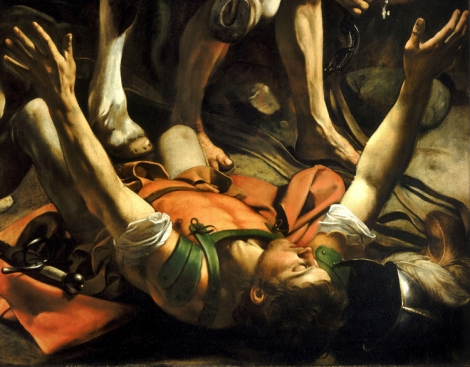
Detail of The Conversion – from Lets Explore Art (https://letsexploreart.wordpress.com/2014/10/09/light-and-dark-caravaggios-paul/)
The next section of the poem speculates as to what the painter might have meant:
No Ananias croons a mystery yet,
Casting the pain out under name of sin.
Thom Gunn was an atheist and in those two lines he’s rejecting any Christian interpretation of Paul’s experience. In the Acts of the Apostles Paul is blinded by his vision but continues on to Damascus where a resident called Ananias gets a divine message to find him and heal his sight. So Gunn is saying that the painting captures a moment before Paul had accepted a (false) Christian interpretation of his experience. Caravaggio gets this right and shows us the real Paul before he was misled by Christian terms like ‘sin’:
The painter saw what was, an alternate
Candor and secrecy inside the skin.
Caravaggio, unlike the author of the Acts, is not so blinded by his faith that he can’t see ‘what was’. His Paul, Gunn suggests, is an honest man but one with secrets. What happens next in the poem is a bit strange: rather than elaborate on this theme, Gunn apparently goes off on a tangent and describes some other Caravaggio works and recounts a story that I think is no longer given much credence about the painter’s murder by a young man he’d picked up:
He painted, elsewhere, that firm insolent
Young whore in Venus’ clothes, those pudgy cheats,
Those sharpers; and was strangled, as things went,
For money, by one such picked off the streets.
‘Pudgy cheats’ is a reference to a well-known painting called The Cardsharps:

Caravaggio – nAFtN9HI0FxbaQ at Google Cultural Institute maximum zoom level, Public Domain, https://commons.wikimedia.org/w/index.php?curid=23608545
I’m not sure about the ‘firm insolent/ Young whore in Venus’ clothes’ though. Caravaggio, like other artists of the time, sometimes used prostitutes as models but I haven’t been able to find a work of his that matches the description.
Anyway, the poem was first published in 1958 and Gunn is being careful. He’s hinting that Paul’s secrets are sexual ones, possibly homosexual ones. Caravaggio was most likely gay and Gunn was openly so. Born in England, he followed the path beaten by Auden and Isherwood – who we tracked a couple of years ago in Berlin – to a big American city – in his case San Francisco – where he was much freer to live the life he wanted. But actually the idea of Paul as secretive and possibly gay does have some support: in 2 Corinthians Paul mentions a ‘thorn in my flesh’ and this has been interpreted as migraines, malaria, epilepsy, bad eyesight – all kinds of things, including homosexuality. I don’t think that’s a very popular theory these days, but Paul certainly keeps the nature of the thorn ‘secret’!
This is a good time to say that I don’t think Gunn for one moment believed that Caravaggio’s interpretation of the incident on the road to Damascus was the one that he’s offering in this poem. Caravaggio was a Christian and understood the passage in Acts as – well, as Gunn himself puts it, ‘Saul becoming Paul’, a description of the violent birth of a Christian hero. The poem’s first stanza has told us ‘the very subject {of the painting} is in doubt’ and what Gunn gives us is his own attempt to pluck meaning out of obscurity, not to offer a historically accurate ‘reading’ of the painting.
We get Gunn’s own ‘vision’ in the tremendous concluding stanza, which to my mind is the best thing in the post-war English poets:
I turn, hardly enlightened, from the chapel
To the dim interior of the church instead,
In which there kneel already several people,
Mostly old women: each head closeted
In tiny fists holds comfort as it can.
Their poor arms are too tired for more than this —
For the large gesture of solitary man,
Resisting, by embracing, nothingness.
The poet leaves the Chapel ‘hardly enlightened’, still not really understanding what the painter was trying to communicate – and there’s a pun here too as the poem is full of images of light and dark, partly as hommage to Caravaggio’s mastery of chiaroscuro. But as he re-enters the main body of the church, he sees the faithful kneeling at prayer – ‘mostly old women’, and some cradling their heads in their hands. Now he understands! Their gesture is the opposite of Paul’s; it’s an attempt by the weary and the defeated to administer a kind of self-hugging that will give them a little comfort in their misery. So what’s Paul doing flinging open his arms like that? Not comforting himself obviously, but the key word is the one the poem ends with- ‘nothingness’. Gunn postulates that Paul is doing two impossible and apparently contradictory things at once: how can you resist nothingness, how can you embrace it, and above all how can you do both at the same time?
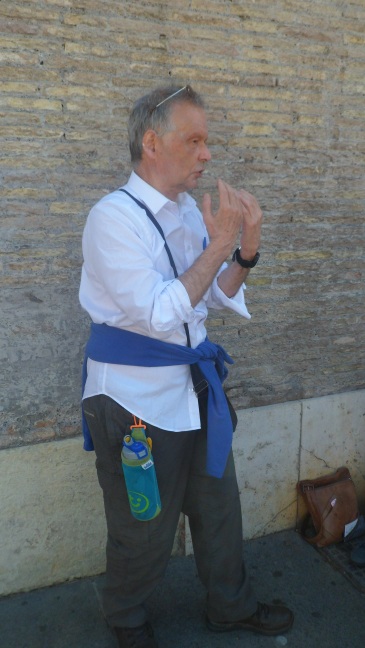
Photo: Chrissie
To answer these questions we need to realise that ‘nothingness’ is a technical term in a form of philosophy that European intellectuals were much concerned with in the post-war period.
In 1943, in the middle of the German occupation of Paris, Jean-Paul Sartre published the first important statement of his Existentialist philosophy – Being and Nothingness. As someone pointed out, that must be the most comprehensive title of all time- it covers everything! This is a long and very difficult text and in 1946 he published L”Existentialisme est un Humanisme (‘Existentialism is a {form of} Humanism’) which in spite of its rather ponderous title is short and much easier to understand. It’s these two works that formed most of the basis of Sartre’s influence when Gunn was writing (the poem was first published in the October 1958 issue of a magazine called Poetry).
Our target word ‘nothingness’ is in the title of the first of the two books I mentioned, so what does it mean? A number of things, and I’ll offer an inevitably simplified discussion of the ones most relevant to Gunn’s re-interpretation of the Caravaggio.
Sartre starts from the position taken by some earlier philosophers who believed that consciousness must always be consciousness of something. Is that your experience? It is mine. If I now become conscious of my consciousness, as it were, I’m aware of hearing the sound of the fountain, of seeing you all, of the heat of the sun – of all kinds of sensations, thoughts and feelings. But this means that, although everything depends on it, my self has no independent existence. It is, we could say, nothing!
So what happens when I am conscious of something?
To understand this look at one of the things I might become conscious of: my boots. I can see they’re brown – and, for the boots themselves, there’s an end of it! They can’t do anything with that brownness – they will never alter, contemplate or resist their own brownness. But my consciousness is different and there is nothing that enters it in that total and unarguable way – everything that enters it comes in, as it were, with freedom at its edges – if my memory is correct, Sartre’s image is that everything in consciousness is contained in a shell of nothingness. The objects of consciousness -which of course include feelings and ideas – never fill us or force us – and when I think about doing something, I always know I can do something else. This is why Sartre claims that freedom is not something ‘added on’ to consciousness but part of its very nature:
Man does not exist first in order to be free subsequently; there is no difference between the being of man and his being-free. ((Being and Nothingness, translated Hazel Barnes, p. 25))
An example might make this clearer: let’s say I’ve not eaten for two days and my consciousness is apparently filled with an insistent and compelling hunger; I’m on my way to the fridge, where I know there to be a cheese sandwich made just the way I like it, when I hear a cry from my neighbour’s child, who’s managed to get herself stuck up the ladder and is swaying precipitously in the breeze. Neither in law nor in public opinion would I be justified in continuing my course to the fridge instead of taking the quick action that might save her life.
Sartre assumes it’s always like that, nothing enters consciousness in such a way as to deprive us of our freedom, and most of us would agree that, in the case I’ve imagined, to try to justify ignoring the child with ‘But I was really hungry – I had no choice’ is a piece of self-deceptive ‘bad faith’ – Sartre’s name for the process by which we deny our own freedom.
Let’s focus now on how we use – or rather live- that inevitable freedom. I think Gunn’s poem is chiefly interested in acts that we might want to call moral – so where does an Existentialist morality come from?
Not from religion, as it did for Paul and Caravaggio. Sartre described his philosophy as an attempt to take atheism to its logical conclusion, and one of his explanations for why there is no ‘human nature’ is that there is no God to have a concept of it. But what about a non-religious concept of ‘human nature’ – is that any help to us in our quest for moral grounding?
Sartre has various arguments against any concept of ‘human nature’ none of which I find very convincing because I think that if there are no species-specific ‘natures’ then the theory of Evolution is meaningless – and I don’t accept the idea of Simone de Beauvoir, fine Existentialist philosopher though she was, that the nature of humanity is to have no nature. But actually I don’t believe this matters very much. People like Richard Dawkins say that we don’t need Christianity and other moral systems because moral behaviour is built into human nature. As we’ve seen, Sartre would agree we don’t need – and can’t have – religion, but what about the idea that Darwinian evolution has given us genetically inherited moral feelings and principles?
Imagine that there’s a starving man over there in the Piazza – surely I’d feel compassion and want to do something about it? Simply because I’m human?
Well, what if I don’t? The Marquis de Sade didn’t, to put it mildly, and I think he disposed of the Enlightenment version of this cosy optimism once and for all. And, more importantly from our point of view this morning, Sartre would say that such impulses would enter my consciousness in a manner that would force me to choose what to do about them. By the way, I should note that Sartre would disapprove of an image like ‘enter my consciousness’ but I think that this straightforward way of talking about experience enables us to grasp his meaning well enough.
So I disagree with Sartre to some extent here: I do believe that as a human animal I have a particular nature – although I don’t see much evidence that universal compassion is part of it – but this never makes me act in one way rather than another, it never removes the great Existentialist imperative – ‘Choose!’
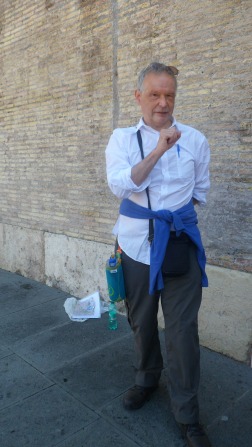
Photo: Chrissie
And that brings us to the crucial sense of ‘nothingness’ in our poem. On what basis should I make that choice?
There is no such basis, of course. Remember we are taking atheism to its extreme but inevitable conclusion so there is no God to tell us on what grounds we should make moral choices – or any choices for that matter, as Sartre tells us we are ‘abandoned to the intolerable necessity of making {ourselves} – down to the slightest detail’ ((Being and Nothingness, p.441)). Nor can there be any secular moral authority – we’ve seen that human nature even if it exists won’t do the job of providing standards or emotions to live by. So how do we know what ideals or feelings should guide our choices?
We know the answer by now: Choose!
Choose the basis on which you will choose your acts. And even when you’ve chosen, say, to base your life on compassion, or the struggle for socialism, you have to choose that over again at every moment – I’m sure you can see that Sartre’s theory of the self means that not even our own past commitments can take away our freedom in the present.
So now we can return to the last lines of the poem and see what Gunn’s doing. He’s turning Paul into an Existentialist hero who embraces, in every sense, his own freedom to be and act in any way he wants.

Photo: Chrissie
I repeat: if Gunn thought Caravaggio meant this, he was quite wrong but I very much doubt he did think that. The painting is of a man embracing his God, his Destiny perhaps – certainly not nothingness!
Sue asked a very perceptive question as we were being transferred to our hotel the other day: is Sartre a nihilist? Actually, you might well think so, and he was accused by some early critics of being nihilist. If there is no God or human nature to set moral standards, why can’t you do anything you like? Well, in Existentialism and Humanism Sartre quotes Dostoevsky who claimed that if there is no God anything is permitted – and he agrees, but without Dostoevsky’s horror at the prospect. ‘Nothing, absolutely nothing, justifies me in adopting this or that particular scale of values’, Sartre tell us somewhere in Being and Nothingness ((p. 38)).
Of course, Sartre at all stages of his career wanted people to act in certain ways, as we all do – one way he tries to get around the apparent inconsistency is to say he’s ‘recommending’ things – for example, accepting your own freedom – not saying you ‘should’ do them. I doubt that’s much more than a verbal distinction, but, although Sartre was not a nihilist in the sense of someone who calls for destructive behaviour or doesn’t care what happens to other people, he was close to being one in the sense of having abandoned the possibility of any kind of imperative morality, even or perhaps especially an Existentialist one.
Which brings me back to Gunn’s conclusion:
…the large gesture of solitary man,
Resisting, by embracing, nothingness.

Of course, the Existentialist must be ‘solitary’ – not like the women who are part of a Church – as the only person who can exercise your freedom is you, on your own with no-one who can compel or justify your decision. Paul is embracing Existentialist nothingness: he’s fully and unconditionally accepting his freedom to choose his own acts and his complete responsibility for them, abandoning all ‘somethings’ like God, human nature, the Kantian Categorical Imperative and so on. But this act of unconditional acceptance is at the same time a ‘resisting’ of nothingness in a slightly different sense of the word: refusing to submit to despair or indifference, refusing to be destroyed by the grim fate of humanity, thrown into the world whether we like it or not, and then left completely to our own devices.’We are left alone, without excuse’, Sartre tells us and this abandonment can be overwhelming, even destructive. He says that the human condition is one of anguish at our freedom and responsibility – we fear things like earthquakes, knife-wielding maniacs and tigers – and we take measures to minimise our risk of encountering them. But we can never escape from the anguish of the need to choose without any grounds on which to base our choice, an anguish made all the worse because in Sartre’s view when we choose for ourself we do so for all human beings at the same time. As we’ve seen, Sartre believes that is the very nature of the self: although when we engage in the actions we’ve chosen we can forget this anguish for a while, it’s always there waiting for us when the next decision arrives.
In the face of such permanent insecurity and un-settlement what’s the best way to avoid psychic obliteration? The best way to avoid a collapse into the despair and indifference of true nihilism? Embrace the nothingness at the heart of humanity completely – don’t look for gods, for moral systems, for comfort or for excuses.
Choose!
Coda:
After some vigorous questions and comments, we went into Santa Mario del Popolo. Assuming Gunn was giving a reasonably accurate description of his experiences, there’s been an important change: the Cerasi chapel and its three masterpieces are now illuminated, although the light went off occasionally and we could get an idea of what it must have been like to view under natural conditions.
Alerted by Gunn’s poem, what jumped out at me was ‘that wide gesture of the lifted’ arms was present in all three of the paintings. The central one is Annibale Carracci’s Assumption of the Virgin, where the gesture suggests triumph at the heavenly reward offered to the virtuous.

Annibale Carracci – Web Gallery of Art: Image Info about artwork, Public Domain, https://commons.wikimedia.org/w/index.php?curid=363471
The painting we’ve been discussing is on your right, and on your left is another Caravaggio, the Crucifixion of St. Peter, in which you can see one of the victim’s arms already nailed to the soon-to-be inverted cross, so the other one is implied, and with it another version of the gesture.
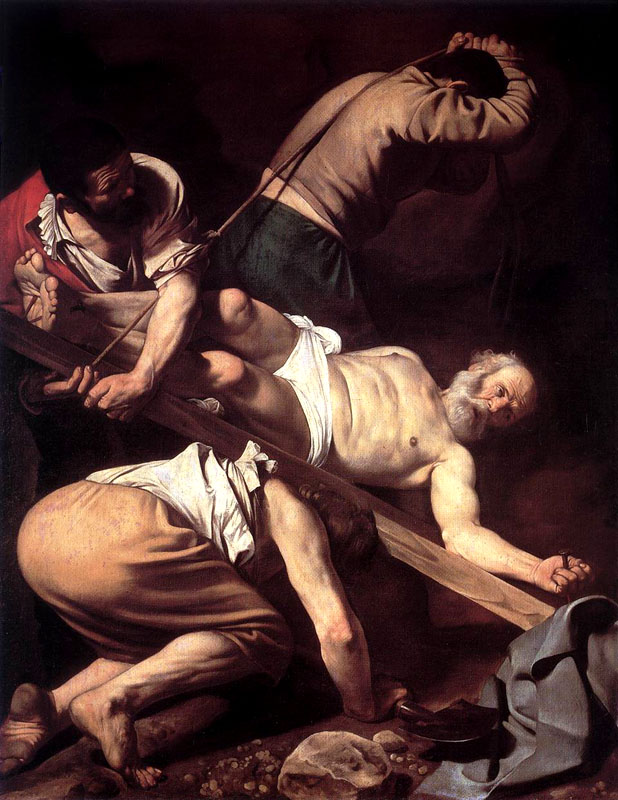
Caravaggio – [1], Public Domain, https://commons.wikimedia.org/w/index.php?curid=363489
The meaning of the three paintings – from this perspective – is ‘accepting God means the possibility of great suffering but the certainty of a greater reward for those who live their lives rightly’. Pretty much the opposite of Gunn’s position.
On leaving the Cerasi Chapel, I was somewhat disappointed to see that no-one on the church benches was cradling their head in their arms.
We took the metro southwards to the Protestant Cemetery where Keats and Shelley are buried – two more ‘splendours of the firmament of time’.
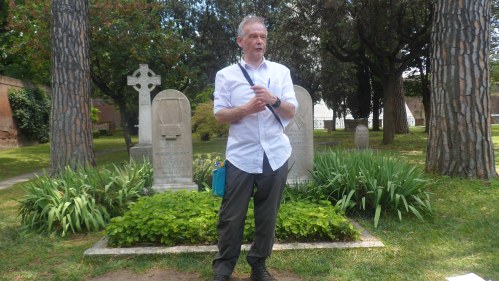
At the Grave of Keats and his friend the painter Joseph Severn: Photo – Chrissie

